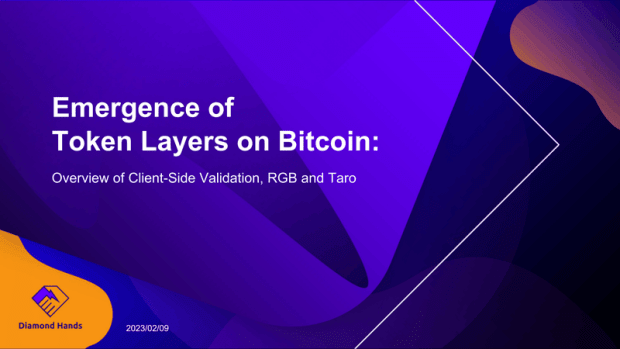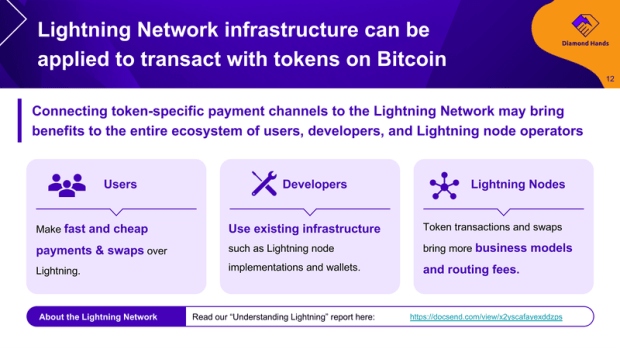RGB and Taro, two protocols able to placing tokens like stablecoins on Bitcoin, have taken completely different approaches to fixing related issues.

That is an opinion editorial by Kishin Kato, the founding father of Trustless Companies Ok.Ok., a Japanese Lightning Community analysis and improvement firm.
Demand for stablecoins on Bitcoin is returning because the Lightning Community gives large scalability benefits. At present, customers in rising markets who wish to transact and save in USD will accept stablecoins on different chains, in line with proponents. Placing my private emotions about these different blockchains apart, I need to acknowledge that bitcoin acquired in low cost, cross-border remittances can’t simply be offered for {dollars} whereas they reside in non-custodial Lightning channels.
RGB and Taro are two new protocols that allow token issuance on Bitcoin, and are subsequently anticipated to carry stablecoin transactions on Lightning. I studied these protocols and the client-side validation paradigm that they make use of and printed a report on my findings referred to as “Emergence Of Token Layers On Bitcoin” by Diamond Palms, a serious Japanese Lightning Community person and developer neighborhood and Bitcoin-focused resolution supplier.
Throughout this analysis, I seen delicate variations in how these seemingly-similar protocols have been being developed, and have become fascinated by how these variations might have an effect on their trajectories. On this article, I wish to share my impressions of those initiatives and the way they could have an effect on Lightning as we all know it.

Priorities And Mindset, Revealed By way of Protocol Improvement
Protocol improvement just isn’t straightforward, and infrequently takes years. Deciding what options to prioritize and compromise on is vital, and one of many major differentiators between RGB and Taro is the selections they’ve made in that regard.
RGB, with its ambitions as a smart-contracting layer on prime of Bitcoin (i.e., not only for tokens), has a strong on-chain protocol to execute off-chain state transitions. Cautious design has resulted in superior privateness, on-chain scalability and flexibility, at the price of conceptual complexity. However, Taro appears to be extra centered on off-chain use, comparable to on the Lightning Community, specifying strategies for multi-hop funds and token alternate. Nonetheless, among the many sensible shortcuts Taro has taken in favor of conceptual simplicity is its neglect to standardize at the least one primary constructing block of its on-chain protocol.

Since Taro belongings are saved utilizing an on-chain UTXO, Taro transactions can theoretically be constructed in two methods: one the place the sender pays bitcoin for the recipient’s output, and the opposite the place the recipient contributes their very own enter to pay for it themselves. The previous case is less complicated, however the sender is successfully gifting some bitcoin; the latter will be extra exact, however requires sender-recipient interplay to create the transaction. Until these strategies and their choice are standardized, pockets interoperability is a pipe dream.
Maybe Taro’s reluctance to standardize such a primary part will be defined by its strategy to improvement. Total, whereas RGB is being developed fairly transparently, Lightning Labs appears to order extra management over its challenge in Taro, probably to take a extra iterative, feedback-based strategy to bringing its product to market.
Certainly, as soon as a protocol is broadly adopted it’s tough to replace or substitute with out breaking interoperability. Nonetheless, this isn’t essentially the case in case your implementation is the one one. Lightning Labs could also be reserving its potential to quickly iterate by deliberately suspending widespread adoption of the protocol. I received this impression from the aforementioned hole in standardization, in addition to the truth that Lightning Labs plans to ship its Taro pockets with LND, its Lightning node implementation with greater than 90% market share.
It’s actually potential that Lightning Labs’ strategy will probably be extra profitable at bringing tokens to Lightning. However until it surrenders its dominant function in some unspecified time in the future, Taro dangers changing into little greater than an LND API. It’s not unimaginable to me that Taro will stay an LND-specific function.
Will Lightning Survive Tokens?
As a semi-paranoid Bitcoiner, I need to surprise if the proliferation of tokens on Bitcoin will lead to unfavorable penalties for the Lightning Community or Bitcoin itself. Whereas issues of the latter are validated by Circle’s (the issuer of USDC) potential to affect customers throughout any potential contentious onerous fork in Ethereum, I wish to level out a selected avenue of concern for Lightning.
As talked about earlier, Taro’s strategy if continued will consequence within the elevated utility of LND by use of its included Taro pockets, in relation to different implementations. This may doubtlessly additional lock in LND’s dominant place within the node implementation panorama. To maintain Lightning decentralized, it’s preferable that customers are unfold extra evenly throughout a number of implementations, in order that even the preferred implementation can’t merely implement protocol modifications with out consequence to its customers.

Whereas I personally am not a fan of the overwhelming majority of crypto tokens, I do consider that the Lightning Community has one thing to prospectively supply customers of such tokens: quick, personal and decentralized alternate and funds. Having the ability to pay somebody of their native or most popular foreign money immediately, with out the sender proudly owning any of it, has immense potential to disrupt present cost and remittance rails. Although it’s unclear what protocol will prevail for token issuance on Bitcoin, I hope that proliferation of tokens is not going to sacrifice the issues that bitcoin and Lightning stand for.
This can be a visitor publish by Kishin Kato. Opinions expressed are totally their very own and don’t essentially replicate these of BTC Inc or Bitcoin Journal.









![Methods to Purchase DeFi Pulse Index on CoinStats [The Ultimate Guide 2022]](https://bitrrency.com/wp-content/uploads/2022/05/DeFi_Pulse_og-100x70.png)

